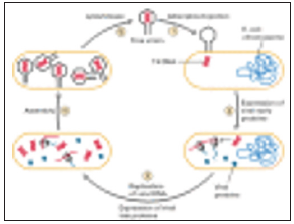- Submissions

Full Text
COJ Biomedical Science & Research
Study of Viruses Material
Kheyrodin H*
Department of Desert Science, Iran
*Corresponding author: Kheyrodin H, Department of Desert Science, Iran
Submission: October 22, 2020; Published: April 16, 2021

Volume1 Issue5April 2021
Abstract
Most viruses have either RNA or DNA as their genetic material. The nucleic acid may be single- or doublestranded. The entire infectious virus particle, called a virion, consists of the nucleic acid and an outer shell of protein. The simplest viruses contain only enough RNA or DNA to encode four proteins. A virus is a small parasite that cannot reproduce by itself. Once it infects a susceptible cell, however, a virus can direct the cell machinery to produce more viruses. Most viruses have either RNA or DNA as their genetic material. The nucleic acid may be single- or double-stranded.
Keywords: Nucleic acid; Structure; Uses; Viruses
Introduction
In many cases, DNA viruses utilize cellular enzymes for synthesis of their DNA genomes and mRNAs; all viruses utilize normal cellular ribosomes, tRNAs, and translation factors for synthesis of their proteins. Most viruses commandeer the cellular machinery for macromolecular synthesis during the late phase of infection, directing it to synthesize large amounts of a small number of viral mRNAs and proteins instead of the thousands of normal cellular macromolecules.
The nucleic acid of a virion is enclosed within a protein coat, or capsid, composed of multiple copies of one protein or a few different proteins, each of which is encoded by a single viral gene. Because of this structure, a virus is able to encode all the information for making a relatively large capsid in a small number of genes. This efficient use of genetic information is important, since only a limited amount of RNA or DNA, and therefore a limited number of genes, can fit into a virion capsid [1]. A capsid plus the enclosed nucleic acid is called a nucleocapsid. Nature has found two basic ways of arranging the multiple capsid protein subunits and the viral genome into a nucleocapsid. The simpler structure is a protein helix with the RNA or DNA protected within. Tobacco Mosaic Virus (TMV) is a classic example of the helical nucleocapsid. In TMV the protein subunits form broken disklike structures, like lock washers, which form the helical shell of a long rodlike virus when stacked together (Figure 1); [2].
Figure 1:Show virus replication.

There are four types of bacterial viruses are widely used in biochemical and genetic
Here, we briefly describe four types of bacteriophages, all of which infect E. coli, that have been especially useful in molecular biology research. The T phages of E. coli are large lytic phages that contain a single molecule of double-stranded DNA. This molecule is about 2 × 105 base pairs long in T2, T4, and T6 viruses and about 4 × 104 base pairs long in T1, T3, T5, and T7 viruses. T-phage virions consist of a helical protein “tail” attached to an icosahedral “head” filled with the viral DNA. After the tip of a T-phage tail adsorbs to receptors on the surface of an E. coli cell, the DNA in the head enters the cell through the tail (Figure 2). The phage DNA then directs a program of events that produces approximately 100 new phage particles in about 20 minutes, at which time the infected cell lyses and releases the new phages. The initial discovery of the role of messenger RNA in protein synthesis was based on studies of E. coli cells infected with bacteriophage T2. By 20 minutes after infection, infected cells synthesize T2 proteins only. The finding that the RNA synthesized at this time had the same base composition as T2 DNA (not E. coli DNA) implied that mRNA copies of T2 DNA were synthesized and used to direct cellular ribosomes to synthesize T2 proteins [3].
Figure 2:Viral growth cycles are classified as lytic.

Conclusion
a) Viruses are intracellular parasites that replicate only after infecting specific host cells. Viral infection begins when proteins on the surface of a virion bind to specific receptor proteins on the surface of host cells. The specificity of this interaction determines the host range of a virus.
b) Aside from being the causative agents of many diseases, viruses are important tools in cell biology research, particularly in studies on macromolecular synthesis.
c) Viruses can be counted and cloned by the plaque assay. All, the virions in a single plaque compose a clone derived from the single parental virion that infected the first cell at the center of the plaque.
d) Individual viral particles (virions) generally contain either an RNA or a DNA genome, surrounded by multiple copies of one or a small number of coat proteins, forming the nucleocapsid. The nucleocapsid of many animal viruses is surrounded by a phospholipid bilayer, or envelope.
e) During lytic replication, host-cell ribosomes and enzymes are used to express viral proteins, which then replicate the viral genome and package it into viral coats.
f) Some bacterial viruses (bacteriophages) may undergo lysogeny following infection of host cells. In this case, the viral genome is integrated into host-cell chromosomes, forming a prophage that is replicated along with the host genome.
g) Recombinant viruses can be used as vectors to carry (transduce) selected genes into cells. In this approach, viral genes required for the lytic cycle are replaced by other genes.
Acknowledgement
We thank Semnan university cause grant and fee preparation for this work.
References
- O'Leary JJ, Kennedy MM, McGee JO (1997) Kaposi's sarcoma associated herpes virus (KSHV/HHV 8): Epidemiology, molecular biology and tissue distribution. Mol Pathol 50(1): 4-8.
- Koonin EV, Dolja VV, Krupovic M, Varsani A, Wolf YI, et al. (2019) Create a megataxonomic framework, filling all principal taxonomic ranks, for ssDNA viruses. International Committee on Taxonomy of Viruses.
- Malathi VG, Devi RP (2019) ssDNA viruses: Key players in global virome. Virusdisease 30(1): 3-12.
© 2021 Kheyrodin H. This is an open access article distributed under the terms of the Creative Commons Attribution License , which permits unrestricted use, distribution, and build upon your work non-commercially.
 a Creative Commons Attribution 4.0 International License. Based on a work at www.crimsonpublishers.com.
Best viewed in
a Creative Commons Attribution 4.0 International License. Based on a work at www.crimsonpublishers.com.
Best viewed in 







.jpg)






























 Editorial Board Registrations
Editorial Board Registrations Submit your Article
Submit your Article Refer a Friend
Refer a Friend Advertise With Us
Advertise With Us
.jpg)






.jpg)














.bmp)
.jpg)
.png)
.jpg)










.jpg)






.png)

.png)



.png)






